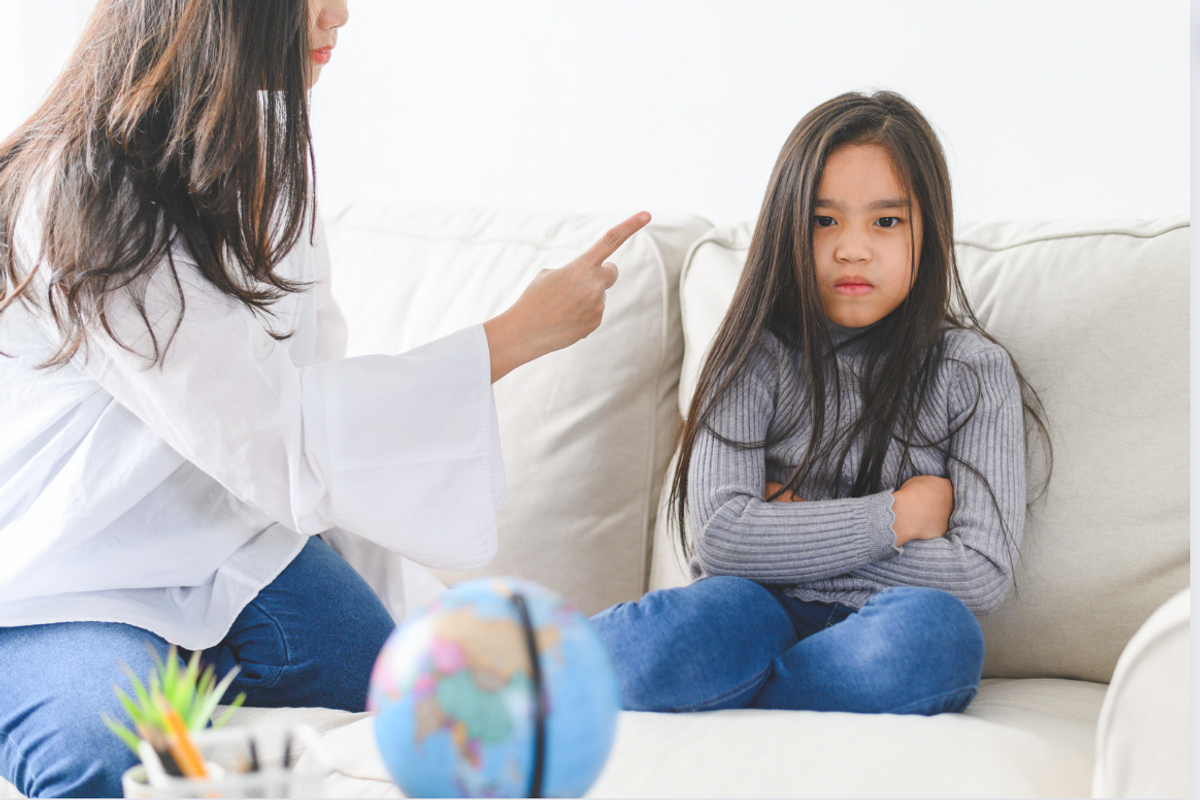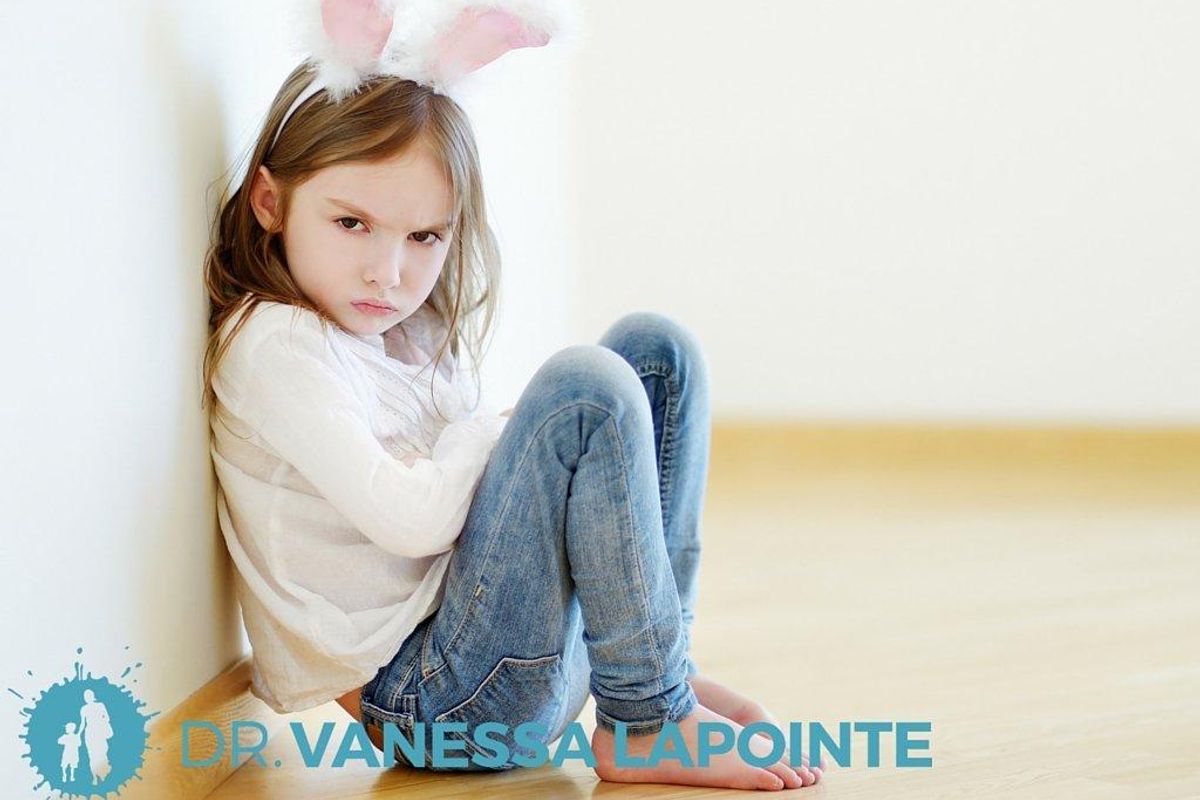Therapist shares science-backed phrases that parents can use to gently defuse a meltdown
It's perfectly natural to want to raise your voice when a toddler is having a tantrum. But experts say there is a better way.

Finger pointing is actually NOT one of the suggested strategies
When your toddler has a meltdown, it's perfectly natural to want to fly off the handle.
There's nothing more infuriating than a small human repeatedly demanding something that's physically impossible for you to give them, or wailing because you had to punish them after repeatedly telling them to knock it off.
"I CREATED YOU, YOU LITTLE MONSTER. I CAN DESTROY YOU," you might want to say (though you never would). You love your kids — of course you do — but damn if they aren't the best at pushing you to your breaking point.
As tempting as it may be to raise your voice, yell, and keep ramping up the punishment to ridiculous levels, some parenting experts say there's a much better option.
Vanessa Lapointe, a mom and professional psychologist, suggests something called "discipline without damage."
Lapointe defines this practice, sometimes called "compassionate parenting," as an intervention that reinforces connection, not separation — in other words, staying calm and kind while setting firm boundaries for kids in a way that doesn't dampen their spirits or preach obedience above all else.
This isn't just some new-agey, feel good stuff: Lapointe says it's all based on science and the way children's brains develop.
"Our job as parents is to grow up children who are hardy. Not children who are hardened," she explained in an essay for The Huffington Post. "Children who are hardy can weather the storms of life. Children who are hardened cannot, and instead tend to shut down and have ineffective coping strategies."
Lapointe recently released a nifty "Discipline Cheat Sheet" that offers some simple changes to the words we use when faced with a meltdown that can completely change the tenor of the situation for the better.
 The Discipline Cheat Sheet: An Infographic
The Discipline Cheat Sheet: An InfographicHere's how this technique might play out.
Say your toddler colored on the wall with bright green crayon.
Instead of screeching something along the lines of "What were you thinking?!??!" Lapointe recommends using a kind and compassionate tone and saying something more like, "You know I don't want you coloring on the walls. We need to get this cleaned up."
"No!" your kid might respond, with a stomp of a tiny foot. "I don't want to!"
"Come on," you say, keeping your voice calm. "I'll show you where the cleaning supplies are and help you get started."
Now, ideally, that would be enough. Your toddler would calm down and gladly help you clean the walls. When it comes to toddlers, however, parents know things are rarely that easy.
What if by then he's too upset and has thrown himself to the ground in protest, banging fists against the floor? Instead of finally breaking and losing your temper, it's time to try a different tactic from the cheat sheet.
"I can see this is tricky for you. We're going to solve this later. Let's get a drink of water," you can say.
He may agree or not. But eventually, he will calm down (every parent knows that they always do), and you can show him how to get the crayon off the wall.
When the wall is finally clean, turn to him and say, "Let's find a better place to keep your coloring supplies so this doesn't happen again."
The whole conflict may take a while, and you may have to go back to the cheat sheet to try many of these different techniques, but in the end, you get what you want (a clean wall) without yelling at, frightening, or physically forcing your toddler to clean it up. At the same time, your kid learns that their actions have consequences.
The reality is that most toddlers are nearly psychologically incapable of impulse control. No amount of yelling or being a strict disciplinarian can change the wiring of their brains. And though the phrases in the chart above are best for young children, the same principles of compassionate parenting apply to older kids, too.
The chart has been shared far and wide across the web, though Lapointe's approach isn't without its critics.
Some parents worry that her recommendations feel an awful lot like "helicopter parenting" and isn't strong enough to teach kids about independence and feeling the consequences of their actions.
Lapointe says these people are missing the point. She spells out the difference:
"The hoverer is worried, nervous, and uncertain, and prevents their child from ever having to come to terms with the things in life that simply cannot be. The provider is confident, all-knowing, and in charge, and supports the child in regulating around their upset in coming to terms with the things in life that cannot be. "
She urges parents to remember that kids are kids and not to expect them to understand the world as adults do.
Compassionate parenting is more than just a few handy phrases.
The phrases on Lapointe's cheat sheet are a great first step for reframing the way we react when our kids start misbehaving, but they're not the only tool a compassionate parent can keep in their back pocket. For parents looking for an alternative to punishment and escalating behavior, however, Lapointe's cheat sheet could be just the help they need to stay calm in the face of a toddler tornado.
Though easier said than done, a simple, "Come here, I've got you," could be exactly what your kid needs to hear.
This article originally appeared on 07.21.17


 An O Project participant.
An O Project participant.  An O Project participant.
An O Project participant.  An O Project participant.
An O Project participant.  An O Project participant.
An O Project participant.  An O Project participant.
An O Project participant.  An O Project participant.
An O Project participant.  An O Project participant.
An O Project participant.  An O Project participant.
An O Project participant.  An O Project participant.
An O Project participant.  An O Project participant.
An O Project participant.  A woman snuggled up in her duvet coverCanva
A woman snuggled up in her duvet coverCanva Feet poking out from under the coversCanva
Feet poking out from under the coversCanva Gif from "New Girl" of woman trying to make the bed via
Gif from "New Girl" of woman trying to make the bed via  A robot vaccuum.
A robot vaccuum.  A kitty using a self-cleaning litter box.
A kitty using a self-cleaning litter box.  A woman getting LASIK.
A woman getting LASIK.  A loaded dishwasher.
A loaded dishwasher.  A woman waking up well-rested.
A woman waking up well-rested.  A bidet.
A bidet.  A man using a power drill.
A man using a power drill.  An electric kettle and tea.
An electric kettle and tea.  A keypad lock.
A keypad lock.  An air fryer with freshly made potatoes.
An air fryer with freshly made potatoes.  A phone charging.
A phone charging. An espresso machine.
An espresso machine.  Cleaners
Cleaners Laser hari removal
Laser hari removal Bluetooth products
Bluetooth products So many book recommendations, so little time.
So many book recommendations, so little time.  RHCP on cassette is peak Generation Jones.
RHCP on cassette is peak Generation Jones. Gen Jones was there for the launch of the tech revolution.
Gen Jones was there for the launch of the tech revolution.